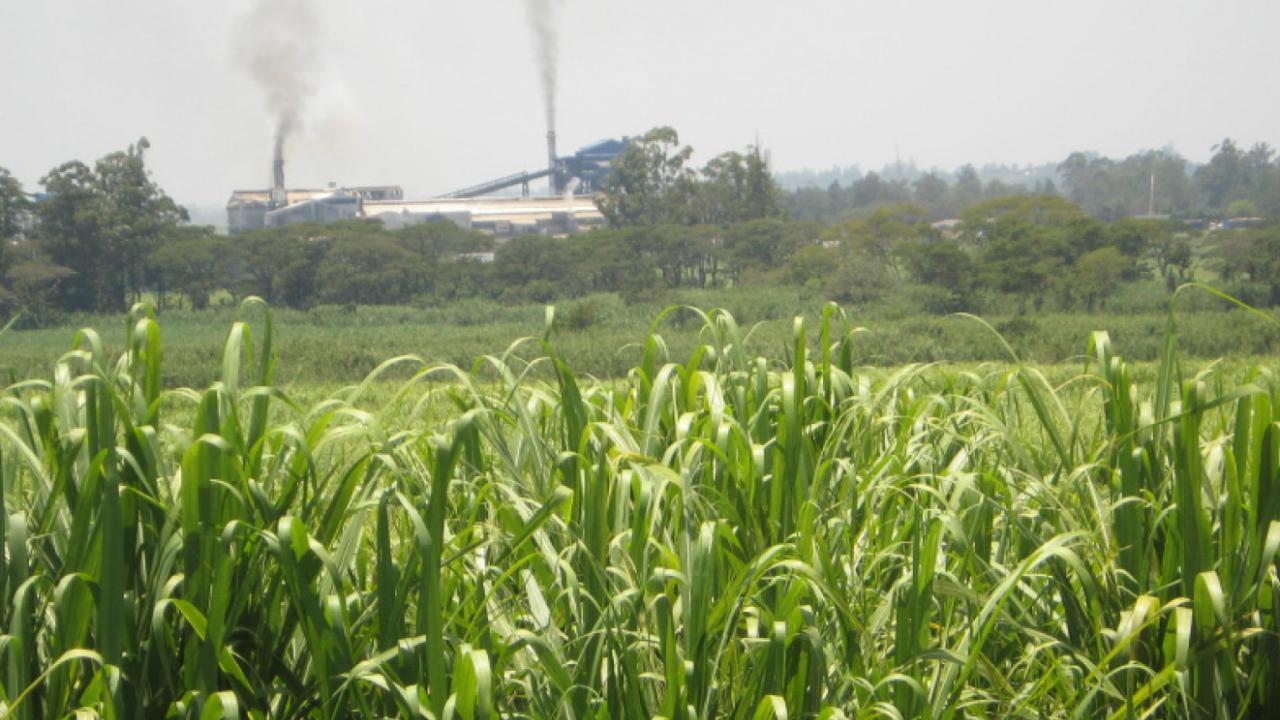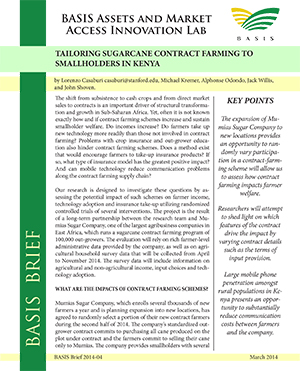
The shift from subsistence to cash crops and from direct market sales to contracts is an important driver of structural transformation and growth in Sub-Saharan Africa. Yet, often it is not known exactly how and if contract farming schemes increase and sustain smallholder welfare. Do incomes increase? Do farmers take up new technology more readily than those not involved in contract farming? Problems with crop insurance and out-grower education also hinder contract farming schemes. Does a method exist that would encourage farmers to take-up insurance products? If so, what type of insurance model has the greatest positive impact? And can mobile technology reduce communication problems along the contract farming supply chain?
Key Points
- The expansion of Mumias Sugar Company to new locations provides an opportunity to randomly vary participation in a contract-farming scheme will allow us to assess how contract farming impacts farmer welfare.
- Researchers will attempt to shed light on which features of the contract drive the impact by varying contract details such as the terms of input provision.
- Large mobile phone penetration amongst rural populations in Kenya presents an opportunity to substantially reduce communication costs between farmers and the company.
 Our research is designed to investigate these questions by assessing the potential impact of such schemes on farmer income, technology adoption and insurance take-up utilizing randomized controlled trials of several interventions. The project is the result of a long-term partnership between the research team and Mumias Sugar Company, one of the largest agribusiness companies in East Africa, which runs a sugarcane contract farming program of 100,000 out-growers.
Our research is designed to investigate these questions by assessing the potential impact of such schemes on farmer income, technology adoption and insurance take-up utilizing randomized controlled trials of several interventions. The project is the result of a long-term partnership between the research team and Mumias Sugar Company, one of the largest agribusiness companies in East Africa, which runs a sugarcane contract farming program of 100,000 out-growers.
The evaluation will rely on rich farmer-level administrative data provided by the company, as well as on agricultural household survey data that will be collected from April to November 2014. The survey data will include information on agricultural and non-agricultural income, input choices and technology adoption.
What Are the Impacts of Contract Farming Schemes?
Mumias Sugar Company, which enrolls several thousands of new farmers a year and is planning expansion into new locations, has agreed to randomly select a portion of their new contract farmers during the second half of 2014. The company’s standardized outgrower contract commits to purchasing all cane produced on the plot under contract and the farmers commit to selling their cane only to Mumias.
The company provides smallholders with several inputs on credit, such as land preparation, seedcane, fertilizer, harvesting, and transportation of the harvested cane to the mill. Input charges (plus interest) are subtracted from farmer payments. This rare opportunity to randomly vary participation in a contract-farming scheme will allow us to assess how contract farming impacts farmer welfare.
We will also attempt to shed light on which features of the contract drive the impact by varying contract details such as the terms of input provision. To do this, we will first study the impact on household agricultural and non-agricultural income by collecting detailed agricultural labor and wage data. Second, we will assess how enrollment in the contract farming scheme affects technology adoption. In particular, we will measure input usage, such as fertilizer, in all crops cultivated by the farmer.
Third, we will study whether joining the contract farming scheme has an impact on household food security. Fourth, we will test whether the likelihood of farmer default (to side sell) depends on contract details such as the amount of inputs a farmer receives from the company and thus the amount owed at harvest.
Testing Demand for Insurance with Bundled Contracts
At the beginning of the agricultural season, credit constraints and myopia may reduce farmer willingness to pay for insurance premiums. However, in the case of contract farming, the company may be able to provide insurance, deducting the cost of premiums at harvest time. This may substantially affect insurance take-up, as typically, it would be hard to convince a farmer to commit to a harvest-time premium payment.
However, nesting insurance in a contract farming arrangement makes this option possible. To assess its viability we will compare insurance take-up when it is either unbundled or bundled with the contract. In the unbundled case, the farmer pays for the product at the beginning of the planting cycle. In the bundled case, the company deducts the insurance premium plus interest from the farmers’ harvest payment.
Basis risk is another well-known deterrent to take-up of weather insurance and reduces its effectiveness in consumption smoothing. An alternative option is to tie insurance compensation to actual average local crop outcomes. Contract farming companies typically collect precise data on farmer output. Mumias also collects information on plot sizes, therefore making yield computation possible. Hence we can offer an area yield insurance product based on both average yield in a defined geographical location and on weather using the rich panel dimension. We will explore the impact of varying the size of the area to study the relative role of moral hazard and basis risk.
Can Mobile Technology Improve Firm Performance & Farmer Outcomes?
In a large outgrowing scheme, traveling distances between farmer dwellings and company field offices are often very large and the company extension staff is limited. Efficient communication is an important determinant for contract farming schemes. The company needs to monitor the plots, for instance by checking whether the farmers have completed crucial tasks such as weeding, and to be able to diffuse information cheaply. The farmers must provide timely feedback to the company about whether land preparation was completed properly or whether fertilizer was delivered at the right time. This is particularly relevant with Mumias as third-party contractors deliver inputs and delays are quite common.
Large mobile phone penetration amongst rural populations in Kenya presents an opportunity to substantially reduce these communication costs. In East Africa, mobile phones have already been proven effective for services such as mobile money transfers, health service delivery, and education. Our research will shed light on how mobile phone usage affects interactions between the company, farmers, and input providers.
The company will select a random sample of farmers to access a hotline service for queries about company services, agricultural practices, and other contractual details. The research team and the company’s Information Technology Department are collaborating to develop a query logging software platform to direct queries and to monitor responses. Using company data, we will test whether access to the hotline affects delays in seedcane and fertilizer delivery.
This has the potential to reduce frictions between the company, the cane suppliers, and the third-party input suppliers. For instance, access to hotline records may allow the company to better monitor contractor performance. Increased efficiency in input provision would benefit both the farmers and the company as timely fertilizer delivery could increase yields thus improving both farmer revenues and company profits.
Anticipated Impacts
Our interventions will assess i) the impact of farmer participation in these schemes on farmer wellbeing, including income, investment, and agricultural technology adoption; ii) the potential of tailored insurance products to raise uptake among smallholders, and iii) the role of mobile communication technology in improving coordination across different links in the agricultural supply chain. We expect to have full results in 2017.
How to improve smallholder producer livelihoods is of central importance in Kenya, where 75% of the working population is employed in agriculture and smallholdings account for the vast majority of agricultural production. The challenges of increasing farmer profitability are many given stagnating agricultural productivity. The role of contract farming, agricultural micro-insurance products, and information communication technologies have each received considerable attention in the current agricultural policy debate. For instance, in 2008 The New Partnership for Africa’s Development (NEPAD) explicitly endorsed contract farming as a tool to promote inclusive agricultural growth.
On the other hand, in a 2011 report, Technoserve and the United Nations International Fund for Agriculture and Development (IFAD) pointed at the challenges of reaching marginalized farmers with these schemes. Similarly, over the last few years, key players such as the Syngenta Foundation and Financial Sector Deepening Kenya, have devoted increased resources to agricultural micro-insurance products. Finally, USAID and others have high hopes for mobile applications to improve farming practices and increase production and welfare.
Our project will contribute to these policy discussions primarily because our experimental analysis will be an important innovation in understanding the impact of contract farming on smallholder welfare. Furthermore, both the proposed insurance products and the mobile phone interventions display high scalability potential. Should the pilot prove successful, Mumias Sugar Company has the potential to quickly scale these up to their entire contract farming scheme.
The results will also be relevant for a large set of players worldwide. For instance, we will present our results to the Kenya Sugar Board and to other contract-farming companies in Kenya. Even more broadly, large farmer cooperatives could easily adopt the interventions for their members. For example, providing insurance products through deduction at payment time will be easily adaptable to different settings. While the focus of our research is on sugarcane, a sector that is expected to expand due to the increased demand for biofuels and bioelectricity, the potential of these interventions should be applicable to other value chains such as horticulture and dairy farming.
This report is made possible by the generous support of the American people through the United States Agency for International Development (USAID). The contents are the responsibility of the Feed the Future Innovation Lab for Assets and Market Access at UC Davis and do not necessarily reflect the views of USAID or the United States Government.
